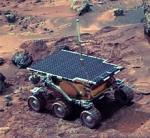Displaying items by tag: low cost
Mars Pathfinder
Mars Pathfinder (MESUR Pathfinder) was an American spacecraft that landed a base station with roving probe onMars in 1997. It consisted of a lander, renamed the Carl Sagan Memorial Station, and a lightweight (10.6 kilograms/23 pounds) wheeled robotic rover named Sojourner.
Launched on December 4, 1996 by NASA aboard a Delta II booster a month after the Mars Global Surveyor was launched, it landed on July 4, 1997 on Mars' Ares Vallis, in a region called Chryse Planitia in the Oxia Palus quadrangle. The lander then opened, exposing the rover which conducted many experiments on the Martian surface. The mission carried a series of scientific instruments to analyze the Martian atmosphere, climate, geology and the composition of its rocks and soil. It was the second project from NASA's Discovery Program, which promotes the use of low-cost spacecraft and frequent launches under the motto "cheaper, faster and better" promoted by the then administrator, Daniel Goldin. The mission was directed by the Jet Propulsion Laboratory (JPL), a division of the California Institute of Technology, responsible for NASA's Mars Exploration Program.
Discovery program
NASA's Discovery Program (as compared to New Frontiers, Explorers, or Flagship Programs) is a series of lower-cost, highly-focused American scientific space missions that are exploring the Solar System. It was founded in 1992 to implement then-NASA Administrator Daniel S. Goldin's vision of "faster, better, cheaper" planetary missions. Discovery missions differ from traditional NASA missions where targets and objectives are pre-specified. Instead, these cost-capped missions are proposed and led by a scientist called the Principal Investigator (PI). Proposing teams may include people from industry, small businesses, government laboratories, and universities. Proposals are selected through a competitive peer review process. All of the completed Discovery missions are accomplishing ground-breaking science and adding significantly to the body of knowledge about the Solar System.
NASA also accepts proposals for competitively selected Discovery Program Missions of Opportunity. This provides opportunities to participate in non-NASA missions by providing funding for a science instrument or hardware components of a science instrument or to re-purpose an existing NASA spacecraft. These opportunities are currently offered through NASA's Stand Alone Mission of Opportunity program.

